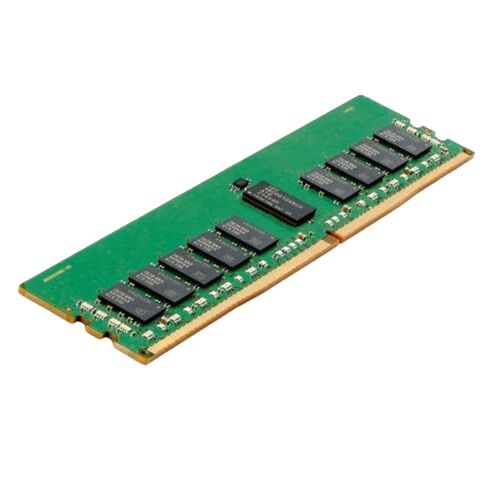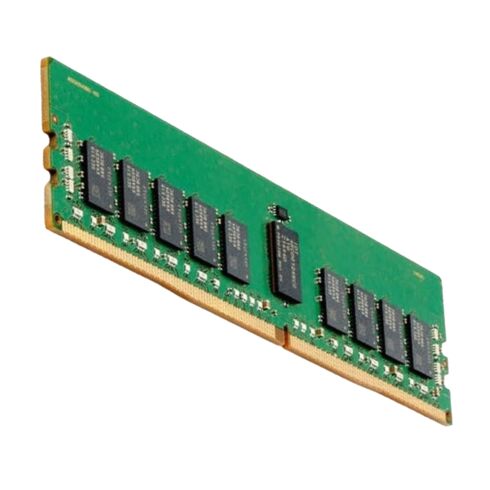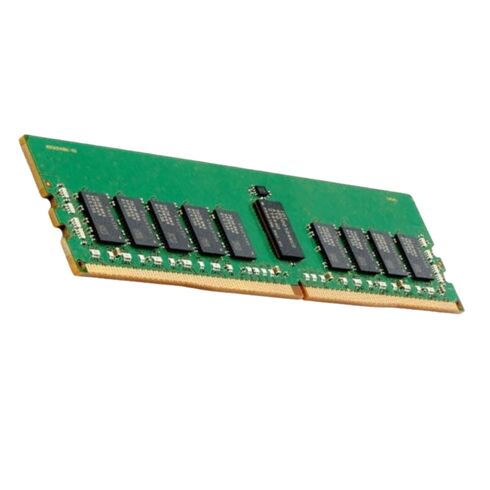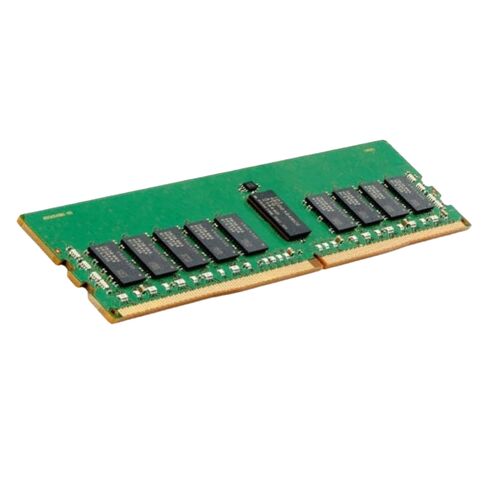P06186-001 HPE 8GB DDR4 RAM 2933mhz PC4-23400 CL21 ECC Reg SDRAM
- — Free Ground Shipping
- — Min. 6-month Replacement Warranty
- — Genuine/Authentic Products
- — Easy Return and Exchange
- — Different Payment Methods
- — Best Price
- — We Guarantee Price Matching
- — Tax-Exempt Facilities
- — 24/7 Live Chat, Phone Support
- — Visa, MasterCard, Discover, and Amex
- — JCB, Diners Club, UnionPay
- — PayPal, ACH/Bank Transfer (11% Off)
- — Apple Pay, Amazon Pay, Google Pay
- — Buy Now, Pay Later - Affirm, Afterpay
- — GOV/EDU/Institutions PO's Accepted
- — Invoices
- — Deliver Anywhere
- — Express Delivery in the USA and Worldwide
- — Ship to -APO -FPO
- — For USA - Free Ground Shipping
- — Worldwide - from $30
Same product also available in:
| SKU/MPN | Warranty | Price | Condition | You save |
|---|---|---|---|---|
| P06186-001 | 1 Year Warranty | Contact us for a price | Factory-Sealed New in Original Box (FSB) | |
| P06186-001 | 1 Year Warranty | $93.00 | New (System) Pull | You save: $32.55 (26%) |
Product Overview of HPE P06186-001
This HPE 8GB (1x8GB) DDR4 memory module is designed to deliver high-speed performance, with its single rank, registered, and error-correcting capabilities making it ideal for demanding systems. Here, we will explore its key features, specifications, and technical details in-depth to give you a clear understanding of this product.
Key Features of the HPE 8GB DDR4 Memory Module
- Storage Capacity: 8GB
- Memory Type: DDR4 SDRAM
- Module Configuration: 1 x 8GB DIMM
- Speed: 2933 MHz (PC4-23400)
- Latency Timings: CL21 (21-21-21)
- Registered Module: Yes, ensuring stability in high-demand environments
- Error Checking: ECC (Error-Correcting Code) support
- Voltage: 1.2V
- Rank: Single Rank X8
Detailed Specifications of HPE 8GB DDR4 Memory Kit
This high-performance memory kit from HPE is built to meet the needs of modern servers and workstations. The module operates at a frequency of 2933 MHz, offering seamless data transfer for enhanced multitasking and application performance.
Memory Configuration and Structure
- Capacity: 8GB, sufficient for many mid-range server setups
- Form Factor: DIMM 288-pin, widely compatible with various motherboards
- Rank: Single Rank, optimizing memory access for increased reliability and efficiency
Performance and Speed
The HPE DDR4 memory kit is engineered to run at an impressive speed of 2933 MHz, offering ample bandwidth for demanding tasks like virtual machines, large databases, or high-performance computing.
Advanced Features for Stability
- Registered: Provides additional stability, particularly in multi-processor configurations
- ECC Technology: Error-Correcting Code ensures data integrity by automatically detecting and fixing memory errors
- Low Voltage: Operates at 1.2V for better power efficiency without compromising performance
System Compatibility
The HPE 8GB DDR4 RAM is system-specific, designed to work seamlessly with supported servers and workstation configurations. It's an ideal upgrade option for systems that require high-speed, error-checked memory.
Product Part Details
- Manufacturer: HPE (Hewlett Packard Enterprise)
- Part Number: P06186-001
- Product Type: RAM Module
Memory Speed and Latency
With a memory speed of 2933 MHz (PC4-23400), this module ensures high data throughput for demanding applications. The CL21 latency (21-21-21) is ideal for users seeking a balance between speed and stability.
Upgrade Your System with HPE Memory
Designed to meet the needs of performance-focused computing environments, the HPE 8GB DDR4 memory kit ensures that your server or workstation has the resources necessary for demanding applications. From its high-speed data transfer to its advanced error-checking features, it provides a reliable upgrade option for critical systems.
Ecc
The HPE 8GB 2933mhz Pc4-23400 SDRAM is equipped with the Ecc (Error Correcting Code) feature. This feature plays a crucial role in ensuring the reliability and stability of the memory module. ECC is a method of detecting and correcting errors that may occur during data storage or transmission. In the context of computer memory, ECC is designed to detect and correct single-bit errors, as well as detect and report multi-bit errors.
Benefits of Ecc
ECC memory offers several benefits for users, especially in critical computing environments where data integrity is of utmost importance.
1. Enhanced Reliability
The primary advantage of ECC memory is its ability to detect and correct errors. By using advanced algorithms and additional parity bits, ECC memory can identify and automatically correct single-bit errors. This ensures that data stored in memory remains accurate and reliable, minimizing the risk of data corruption or loss. In applications such as enterprise servers, workstations, and database systems, where even a minor error can have significant consequences, ECC memory provides an essential layer of protection.
2. Improved System Stability
Errors in memory can cause system crashes, freezes, or even data corruption. ECC memory helps maintain system stability by identifying and correcting errors before they lead to system failures. This is particularly important for mission-critical applications that require uninterrupted operation and minimal downtime. By utilizing ECC memory, users can experience improved system reliability and reduced disruptions.
3. Data Integrity
Data integrity is crucial in various industries, including finance, healthcare, and scientific research. ECC memory ensures that data stored in memory remains accurate and uncorrupted. It provides peace of mind for users who rely on error-free calculations, simulations, or data processing. By preventing errors from propagating throughout the system, ECC memory helps maintain the integrity of critical data and ensures the accuracy of results.
4. Proactive Error Reporting
ECC memory doesn't just correct errors; it also provides proactive error reporting. When an error is detected, ECC memory logs the occurrence and alerts the system administrator or user. This allows for timely investigation and resolution of any underlying issues that may be causing memory errors. Proactive error reporting helps identify faulty components, faulty memory modules, or other potential system vulnerabilities before they can cause significant problems.
5. Compatibility
ECC memory is compatible with non-ECC systems, which means it can be used in standard desktops or laptops without ECC support. In such systems, the ECC functionality is disabled, and the memory functions as non-ECC memory. This flexibility allows users to future-proof their systems and seamlessly transition to ECC-enabled platforms if needed in the future.
Importance of Ecc for Users
The Ecc feature is of paramount importance for users who require a high level of reliability, stability, and data integrity in their computing systems. It offers enhanced protection against errors and ensures that critical applications and processes can run smoothly without interruptions or data corruption. Whether it's in enterprise-grade servers, workstations, or other professional environments where accuracy and precision are vital, ECC memory provides an essential safeguard against memory-related errors.
Registered
The HPE 8GB 2933mhz Pc4-23400 SDRAM is also equipped with the Registered feature. Registered memory, also known as buffered memory, is a type of memory module that includes an additional register between the memory controller and the DRAM chips. This register helps improve system performance by reducing electrical load on the memory controller and allowing for increased memory module densities.
Benefits of Registered Memory
Registered memory offers several advantages for users, particularly in high-performance computing environments that require large amounts of memory and enhanced system efficiency.
1. Increased Memory Capacity
The use of registered memory allows for increased memory module densities. By adding the register to the memory module, the electrical load on the memory controller is reduced. This reduction in electrical load enables the system to support higher-capacity memory modules. In practical terms, it means that users can have access to larger memory configurations, allowing for more data storage, faster performance, and improved multitasking capabilities.
2. Improved Signal Integrity
Registered memory helps improve signal integrity by buffering the signals between the memory controller and the DRAM chips. The register acts as a middleman, ensuring that signals are properly amplified and synchronized before reaching the DRAM chips. This reduction in signal noise and interference leads to fewer transmission errors and better overall system stability. With improved signal integrity, users can experience faster data transfer rates and reduced latency.
3. Enhanced System Performance
The reduced electrical load on the memory controller provided by registered memory allows for improved system performance. By buffering the signals, registered memory reduces the load on the memory controller, enabling it to handle higher frequencies and larger data transfers more efficiently. This results in faster read and write speeds, quicker access to data, and overall improved system responsiveness. For applications that require intensive data processing or complex calculations, registered memory can significantly enhance performance.
4. Scalability
Registered memory offers greater scalability compared to unbuffered memory. The reduced electrical load on the memory controller allows for more modules to be installed in parallel without sacrificing stability or performance. This scalability is particularly beneficial in server environments, where large amounts of memory are essential for handling multiple simultaneous requests and maintaining optimal performance. With registered memory, users can easily expand their memory capacity as their needs grow, without compromising system stability or reliability.
Importance of Registered Memory for Users
The Registered feature is crucial for users who require high-capacity memory configurations and enhanced system performance. It enables the use of larger memory modules, improves signal integrity, and boosts overall system efficiency. Whether it's in data-intensive applications, virtualization environments, or high-performance computing clusters, registered memory provides the necessary foundation for reliable and efficient operations.
Pin Type
The HPE 8GB 2933mhz Pc4-23400 SDRAM features a pin type of 288-Pin. The number of pins on a memory module determines its physical connection to the motherboard. In the case of DDR4 memory modules, the industry standard is 288 pins.
Benefits of 288-Pin Design
The 288-pin design offers several advantages for users, ensuring compatibility, ease of installation, and reliable performance.
1. Compatibility
The 288-pin design is an industry-standard for DDR4 memory modules. This standardization ensures compatibility across a wide range of motherboards and systems that support DDR4 memory. Users can confidently select memory modules with a 288-pin design, knowing that they will fit into their systems and operate seamlessly. Additionally, the standardized pin layout simplifies the process of upgrading or replacing memory modules, as users can easily identify and install compatible modules without any compatibility issues.
2. Easy Installation
The 288-pin design simplifies the installation process by providing a clear and standardized connection interface. The pins on the memory module align with the corresponding slots on the motherboard, ensuring a secure and proper fit. The standardized pin layout eliminates any guesswork or confusion during installation, allowing users to quickly and easily upgrade their memory without requiring specialized knowledge or tools.
3. Reliable Performance
The 288-pin design ensures a reliable and stable connection between the memory module and the motherboard. The increased number of pins allows for improved signal transmission, minimizing the risk of data loss or corruption. By providing a robust physical connection, the 288-pin design helps maintain optimal performance and data integrity. Users can rely on their systems to deliver consistent and dependable performance, even under demanding workloads or resource-intensive applications.
Importance of 288-Pin Design for Users
The 288-Pin design is essential for users who prioritize compatibility, ease of installation, and reliable performance. It ensures that memory modules can seamlessly integrate into a wide range of systems that support DDR4 memory. With its standardized layout and easy installation process, users can effortlessly upgrade or replace memory modules without any compatibility concerns. The reliable performance provided by the 288-pin design ensures that users can rely on their systems to deliver consistent and stable performance in various computing environments.
Ddr Version
The HPE 8GB 2933mhz Pc4-23400 SDRAM is based on DDR4 (Double Data Rate 4) technology. DDR4 is the latest generation of synchronous dynamic random-access memory (SDRAM) and offers several advancements compared to its predecessor, DDR3.
Benefits of DDR4
DDR4 memory provides numerous benefits for users, including improved performance, power efficiency, and future-proofing capabilities.
1. Enhanced Performance
DDR4 memory offers higher data transfer rates and increased memory bandwidth compared to DDR3. The improved architecture allows for faster data access, quicker application loading times, and smoother multitasking. Users can experience snappier system responsiveness, improved overall performance, and enhanced user experience. DDR4 memory is particularly beneficial for resource-intensive applications such as gaming, video editing, and 3D modeling, where every bit of performance counts.
2. Power Efficiency
DDR4 memory operates at a lower voltage compared to DDR3, resulting in improved power efficiency. The reduced voltage not only helps conserve energy but also generates less heat. This is especially important in systems that require high memory capacities or operate under heavy workloads. Lower power consumption translates to lower operating costs and increased system reliability by reducing the strain on the cooling system.
3. Increased Memory Capacities
DDR4 memory supports higher memory densities, allowing for larger memory capacities per module. This enables users to install more memory in their systems, accommodating demanding applications or virtualization environments that require extensive memory resources. With DDR4, users can take advantage of the increased memory capacities and improve the performance of memory-hungry applications.
4. Future-Proofing
DDR4 is the current industry standard for memory modules, and it is expected to remain so for the foreseeable future. By investing in DDR4 memory, users can future-proof their systems and ensure compatibility with upcoming hardware and software releases. DDR4 memory modules will continue to be widely available and supported by new motherboards and processors, ensuring a long lifespan for systems equipped with DDR4 technology.
Importance of DDR4 for Users
DDR4 technology is vital for users who seek improved performance, power efficiency, and future-proofing capabilities. Its enhanced performance allows for faster data access and improved multitasking, benefiting a wide range of applications and workloads. The power efficiency of DDR4 helps reduce operating costs and ensures optimal system reliability. The increased memory capacities offered by DDR4 enable users to meet the demands of memory-intensive applications. Lastly, by adopting DDR4, users can ensure compatibility with the latest hardware releases and enjoy the benefits of future advancements in memory technology.
Part Number
The HPE 8GB 2933mhz Pc4-23400 SDRAM has a part number of P06186-001. The part number serves as a unique identifier for the specific memory module, providing valuable information for compatibility and identification purposes.
Benefits and Importance of Part Number
The part number offers several benefits for users, ensuring accurate identification, compatibility, and ease of procurement.
1. Accurate Identification
The part number serves as a unique identifier for the memory module. It provides precise information about the specific model, capacity, speed, and other relevant specifications. By referencing the part number, users can accurately identify the exact memory module they require, ensuring compatibility and avoiding any potential confusion or compatibility issues.
2. Compatibility Assurance
The part number helps ensure compatibility between the memory module and the system in which it will be installed. Memory modules often have specific requirements regarding voltage, timing, and other parameters. By referencing the part number, users can verify that the memory module is compatible with their system's specifications. This compatibility assurance minimizes the risk of purchasing incompatible memory modules and simplifies the procurement process.
3. Ease of Procurement
The part number facilitates the procurement process by providing a standardized reference for vendors or suppliers. Users can simply provide the part number to their preferred supplier, ensuring they receive the exact memory module they need. This streamlines the procurement process, reduces the chances of ordering incorrect or incompatible modules, and saves time and effort in acquiring the required memory.
Importance of Part Number for Users
The part number is crucial for users who seek accurate identification, compatibility assurance, and ease of procurement for their memory modules. By referencing the part number, users can ensure that they acquire the correct module with the desired specifications. This eliminates compatibility issues and streamlines the procurement process, allowing users to quickly and confidently obtain the memory module they need for their systems.











